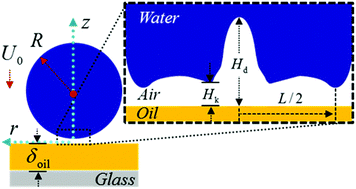Failure mechanisms of air entrainment in drop impact on lubricated surfaces†
Abstract
Lubricated surfaces have recently been introduced and studied due to their potential benefit in various configurations and applications. Combining the techniques of total internal reflection microscopy and reflection interference microscopy, we examine the dynamics of an underlying air film upon drop impact on a lubricated substrate where the thin liquid film is immiscible to the drop. In contrast to drop impact on solid surfaces where even the smallest asperities cause random breakup of the entraining air film, we report two air film failure mechanisms on lubricated surfaces. In particular, using ≈5 μm thick liquid films of high viscosity, which should make the substrate nearly atomically smooth, we show that air film rupture shifts from asperity-driven to a controlled event. At low Weber numbers (We < 2, We = ρlU02R/σ, U0 the impact velocity, R the drop radius, and ρl the density and σ the surface tension of the droplet) the droplet bounces. At intermediate We (2 < We < 10), the air film fails at the center as the top surface of the drop crashes downward owing to impact-induced capillary waves; the resulting liquid–liquid contact time is found to be independent of We. In contrast, at high We (We > 10), the air film failure occurs much earlier in time at the first inflection point of the air film shape away from the drop center, where the liquid–liquid van der Waals interactions become important. The predictable failure modes of the air film upon drop impact sheds light on droplet deposition in applications such as lubricant-infused self-cleaning surfaces.



 Please wait while we load your content...
Please wait while we load your content...